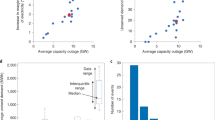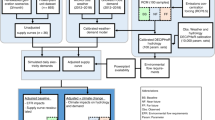Abstract
Hydropower and thermoelectric power together contribute 98% of the world’s electricity generation at present1. These power-generating technologies both strongly depend on water availability, and water temperature for cooling also plays a critical role for thermoelectric power generation. Climate change and resulting changes in water resources will therefore affect power generation while energy demands continue to increase with economic development and a growing world population. Here we present a global assessment of the vulnerability of the world’s current hydropower and thermoelectric power-generation system to changing climate and water resources, and test adaptation options for sustainable water–energy security during the twenty-first century. Using a coupled hydrological–electricity modelling framework with data on 24,515 hydropower and 1,427 thermoelectric power plants, we show reductions in usable capacity for 61–74% of the hydropower plants and 81–86% of the thermoelectric power plants worldwide for 2040–2069. However, adaptation options such as increased plant efficiencies, replacement of cooling system types and fuel switches are effective alternatives to reduce the assessed vulnerability to changing climate and freshwater resources. Transitions in the electricity sector with a stronger focus on adaptation, in addition to mitigation, are thus highly recommended to sustain water–energy security in the coming decades.
This is a preview of subscription content, access via your institution
Access options
Subscribe to this journal
Receive 12 print issues and online access
$209.00 per year
only $17.42 per issue
Buy this article
- Purchase on Springer Link
- Instant access to full article PDF
Prices may be subject to local taxes which are calculated during checkout




Similar content being viewed by others
References
International Energy Statistics (US EIA, accessed 12 January 2015); http://www.eia.gov/cfapps/ipdbproject/IEDIndex3.cfm?tid=2&pid=2&aid=12.
GEA Global Energy Assessment—Toward a Sustainable Future (Cambridge Univ. Press, 2012).
Davies, E. G. R., Kyle, P. & Edmonds, J. A. An integrated assessment of global and regional water demands for electricity generation to 2095. Adv. Water Resour. 52, 296–313 (2013).
Schar, C. et al. The role of increasing temperature variability in European summer heatwaves. Nature 427, 332–336 (2004).
Wetherald, R. T. & Manabe, S. Detectability of summer dryness caused by greenhouse warming. Climatic Change 43, 495–511 (1999).
Hamududu, B. & Killingtveit, A. Assessing climate change impacts on global hydropower. Energies 5, 305–322 (2012).
Lehner, B., Czisch, G. & Vassolo, S. The impact of global change on the hydropower potential of Europe: a model-based analysis. Energy Policy 33, 839–855 (2005).
Förster, H. & Lilliestam, J. Modeling thermoelectric power generation in view of climate change. Reg. Environ. Change 10, 327–338 (2010).
van Vliet, M. T. H. et al. Vulnerability of US and European electricity supply to climate change. Nature Clim. Change 2, 676–681 (2012).
Stucki, V. & Sojamo, S. Nouns and numbers of the water–energy–security nexus in Central Asia. Int. J. Wat. Resour. Dev. 28, 399–418 (2012).
Scanlon, B. R., Duncan, I. & Reedy, R. C. Drought and the water–energy nexus in Texas. Environ. Res. Lett. 8, 045033 (2013).
van Vuuren, D. et al. An energy vision: the transformation towards sustainability—interconnected challenges and solutions. Environ. Sustain. 4, 18–34 (2012).
Olsson, G. Water and Energy: Threats and Opportunities Ch. 9.4, 113 (IWA Publishing, 2012).
Clarke, L. et al. in Climate Change 2014: Mitigation of Climate Change (eds Edenhofer, O. et al.) Ch. 6 (Cambridge Univ. Press, 2014).
Pereira-Cardenal, S. et al. Assessing climate change impacts on the Iberian power system using a coupled water-power model. Climatic Change 126, 351–364 (2014).
Hamlet, A. F., Lee, S.-Y., Mickelson, K. E. B. & Elsner, M. M. Effects of projected climate change on energy supply and demand in the Pacific Northwest and Washington State. Climatic Change 102, 103–128 (2010).
Koch, H., Vögele, S., Kaltofen, M. & Grünewald, U. Trends in water demand and water availability for power plants—scenario analyses for the German capital Berlin. Climatic Change 110, 879–899 (2012).
Liang, X., Lettenmaier, D. P., Wood, E. F. & Burges, S. J. A simple hydrologically based model of land-surface water and energy fluxes for general-circulation models. J. Geophys. Res. 99, 14415–14428 (1994).
Yearsley, J. R. A semi-Lagrangian water temperature model for advection-dominated river systems. Wat. Resour. Res. 45, W12405 (2009).
van Vliet, M. T. H. et al. Coupled daily streamflow and water temperature modelling in large river basins. Hydrol. Earth Syst. Sci. 16, 4303–4321 (2012).
Koch, H. & Vögele, S. Dynamic modelling of water demand, water availability and adaptation strategies for power plants to global change. Ecol. Econ. 68, 2031–2039 (2009).
Hempel, S., Frieler, K., Warszawski, L., Schewe, J. & Piontek, F. A trend-preserving bias correction: the ISI-MIP approach. Earth Syst. Dyn. 4, 219–236 (2013).
van Vuuren, D. P. et al. RCP2.6: exploring the possibility to keep global mean temperature increase below 2 °C. Climatic Change 109, 95–116 (2011).
Riahi, K. et al. RCP 8.5—A scenario of comparatively high greenhouse gas emissions. Climatic Change 109, 33–57 (2011).
van Vliet, M. T. H. et al. Global river discharge and water temperature under climate change. Glob. Environ. Change 23, 450–464 (2013).
Grubler, A. The costs of the French nuclear scale-up: a case of negative learning by doing. Energy Policy 38, 5174–5188 (2010).
Healey, S. Scaling and Cost Dynamics of Pollution Control Technologies: Some Historical Examples (IIASA, 2013).
Projected Costs of Generating Electricity (International Energy Agency and Nuclear Energy Agency, 2010).
Energy Climate and Change—World Energy Outlook Special Report (International Energy Agency, 2015).
Macknick, J., Newmark, R., Heath, G. & Hallett, K. C. A Review of Operational Water Consumption and Withdrawal Factors for Electricity Generating Technologies (National Renewable Energy Laboratory, 2011).
World Electric Power Plants Database (Utility Data Institute, Platts Energy InfoStore, 2013); http://www.platts.com.
Stillwell, A. S. & Webber, M. E. Novel methodology for evaluating economic feasibility of low-water cooling technology retrofits at power plants. Water Policy 15, 292–308 (2013).
Acknowledgements
The Inter-Sectoral Impact Model Intercomparison Project (ISIMIP) is kindly acknowledged for providing the bias-corrected GCM output for this study. M.T.H.v.V. was supported by a contribution from the Niels Stensen Fellowship and a Veni-grant (project 863.14.008) of NWO Earth and Life Sciences (ALW). In addition, this research was part of the Water Futures and Solutions Initiative.
Author information
Authors and Affiliations
Contributions
M.T.H.v.V. designed the study and performed all analyses with input from K.R. and D.W. S.L. assisted in preparing the global data set of power plants. M.T.H.v.V. drafted the manuscript. All authors discussed the results and contributed to the manuscript.
Corresponding author
Ethics declarations
Competing interests
The authors declare no competing financial interests.
Supplementary information
Rights and permissions
About this article
Cite this article
van Vliet, M., Wiberg, D., Leduc, S. et al. Power-generation system vulnerability and adaptation to changes in climate and water resources. Nature Clim Change 6, 375–380 (2016). https://doi.org/10.1038/nclimate2903
Received:
Accepted:
Published:
Issue Date:
DOI: https://doi.org/10.1038/nclimate2903
This article is cited by
-
Efficient osmosis-powered production of green hydrogen
Nature Sustainability (2024)
-
Integrated modeling for assessing climate change impacts on water resources and hydropower potential in the Himalayas
Theoretical and Applied Climatology (2024)
-
Assessing compounding climate-related stresses and development pathways on the power sector in the central U.S.
Mitigation and Adaptation Strategies for Global Change (2024)
-
Leveraging global climate models to assess multi-year hydrologic drought
npj Climate and Atmospheric Science (2023)
-
Global assessment of the carbon–water tradeoff of dry cooling for thermal power generation
Nature Water (2023)



